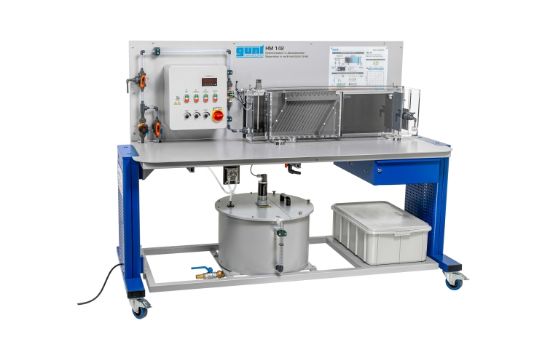The GUNT Sedimentation Tank Separation Trainer is designed to investigate gravity-based separation of solids from suspensions in sedimentation tanks. It provides a comprehensive system for analyzing how flow rates, weir heights, and lamella technology influence sedimentation performance in water treatment processes.
Product Features
- Simulates solid-liquid separation in a sedimentation tank under gravity
- Concentrated suspension prepared from water and solids in a mixing tank
- Pump transfers suspension to sedimentation tank for treatment
- Suspension diluted with fresh water before entering tank via inlet weir
- Upstream stirring machine prevents premature sedimentation
- Treated water flows under a baffle and over an adjustable outlet weir
- Adjustable outlet weir height controls water level in the tank
- Inlet weir height adjustment alters flow velocity into the tank
- Lamella unit insertable to study enhanced separation via inclined plates
- Lamella section includes serrated weir outlet channel for uniform discharge
- Flow rates of fresh and concentrated water adjustable via valves
- Electromagnetic flow sensor monitors inlet flow rate precisely
- Digital display for flow rate and stirring speed
- Integrated tank lighting enhances visibility of flow and sedimentation
Benefits
- Ideal for studying sedimentation tank design and performance
- Demonstrates effects of flow rate, mixing ratio, and weir positioning
- Explores impact of lamella separators on clarification efficiency
- Supports real-time observation of sediment behavior and hydraulic flow
Why Choose the GUNT Sedimentation Separation Trainer?
This advanced trainer provides a controlled environment to explore how solids settle out of suspension in gravity-based systems. With adjustable weirs, precise flow control, and optional lamella integration, it serves as a valuable teaching and research tool for water treatment, civil engineering, and environmental science education.

